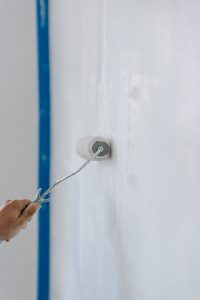-
Plaster Repair Company: Signs You Need Professional Help
Identifying and addressing plaster damage promptly can help save you from costly repairs down the line. Common signs indicating the need for plaster repair include cracks, bulging, or flaking in areas like pools or walls. Hiring a professional plaster repair company can help you tackle these problems effectively and complete your project with a fresh coat of plaster. They have the expertise, materials, and methods to coat plaster cracks with precision, saving you time and ensuring long-lasting results.
Scroll down for reviews of our top picks!
Visible Cracks and Crevices
Visible cracks and crevices are early indicators of plaster damage, signaling potential issues with the structural integrity of a building coat. These imperfections can be classified into different types such as hairline cracks, patterned cracks, or wide gaps. Each type may indicate distinct underlying causes including settling foundations, moisture infiltration, or poor workmanship during the initial plaster application.
If left untreated, these cracks have the potential to worsen over time. For instance, small hairline cracks can expand due to temperature fluctuations and natural shifts in a building’s structure. Moisture seeping into these crevices can also lead to further deterioration as it weakens the plaster material and creates an environment conducive to mold growth.

Addressing these visible signs of plaster damage is crucial for preventing more extensive and costly repairs down the line. Professional repair services can accurately diagnose the root cause of each plaster crack type and implement appropriate remedies tailored to each situation. By addressing plaster cracks promptly, property owners can safeguard their investment from escalating damages while ensuring a safe and aesthetically pleasing living or working environment.
In some cases where minor cracking is noticed but not yet severe enough to warrant professional intervention immediately, property owners should still keep a close eye on them for any progression. Regular monitoring allows for timely action if there are indications that the condition is deteriorating.
Soft Plaster Indicating Water Damage
Soft or crumbly plaster is a clear indication of water infiltration. When the plaster becomes soft to the touch, it often means that water has seeped through and compromised its integrity. This can be observed as discolored patches, peeling paint, or even visible mold growth on the surface.
Potential sources of water damage behind the plaster include leaky pipes, roof leaks, poorly sealed windows or doors, and condensation buildup. Identifying these sources is crucial in preventing further damage and ensuring effective repairs.
The importance of identifying and fixing the underlying issue cannot be overstated. Ignoring wet plaster can lead to structural issues such as wood rot, rusted metal components within walls, electrical hazards from exposed wiring affected by moisture, and mold infestations that pose health risks.
Addressing wet plaster promptly not only prevents costly repairs but also safeguards the health and safety of occupants. A professional plaster repair company can accurately diagnose the extent of water damage behind soft plaster and implement effective solutions to rectify both visible signs of damage and hidden issues.
Plaster Bubbles or Blistering
Bubbles and blistering in plaster surfaces are often caused by moisture and air pockets trapped during the application process. When water-based paint or excessive moisture gets absorbed into the plaster, it can lead to bubbles forming on the surface. If there are air pockets behind the plaster during installation, this can also result in blistering over time.
Moisture seeping through walls from plumbing leaks or inadequate waterproofing can exacerbate these issues. If left unaddressed, bubbles in plaster can lead to further damage such as cracks and peeling of paint layers. Moreover, they may indicate underlying structural problems that need professional attention.
To prevent these problems, it’s crucial to address any sources of excess moisture and ensure proper ventilation within the property. Properly sealing any cracks or holes in the walls before applying new plaster is essential for preventing future bubbling issues.

Discoloration and Staining
Discoloration and staining on plaster can be caused by various factors, including water damage, mold growth, smoke residue, and even certain cleaning products. Identifying the source of the discoloration is crucial before attempting any removal process to ensure effective results.
Common types of stains on plaster include water stains, rust stains, and mold or mildew stains. Water stains are often caused by leaks or excessive moisture seeping through the walls. Rust stains may result from metal objects coming into contact with the plaster over time. Mold or mildew stains typically occur in damp environments with poor ventilation.
It’s important to determine the underlying cause of these stains because simply covering them up without addressing the root issue can lead to recurring problems. For instance, painting over a water stain without fixing the leak causing it can result in peeling paint and continued water damage.
Before removing any type of stain from plaster surfaces, it’s essential to address its source first for long-term effectiveness. This approach not only ensures that discoloration is effectively treated but also prevents future occurrences.
Understanding these common causes of discoloration and staining on plaster helps homeowners make informed decisions when dealing with such issues. By addressing these concerns at their roots rather than just treating surface-level symptoms, they can maintain a healthy environment within their homes while preserving the integrity of their plaster surfaces.
Dampness on Walls or Ceilings
Recognizing dampness is crucial as it often signals underlying plaster damage. Water seepage through cracks, leaks, or poor ventilation can lead to the deterioration of plaster, causing unsightly blemishes and compromising structural integrity.
Prolonged dampness can result in mold growth, which poses health risks and further weakens the plaster. It may cause paint to blister and peel off, leading to costly repainting jobs. Addressing dampness promptly is essential to prevent these consequences.
Professional assessment by a reputable plaster repair company is necessary to accurately identify the root cause of the dampness. Trained specialists have the expertise and tools to conduct thorough inspections and determine whether the issue stems from plumbing problems, external water ingress, or condensation buildup.
Sagging or Bulging Plasterwork
Understanding why plaster may sag or bulge over time is crucial. This can occur due to various reasons such as water damage, structural movement, or improper installation. For instance, prolonged exposure to moisture weakens the bond between the plaster and its base, leading to sagging.
Sagging or bulging plasterwork could indicate potential structural issues within a building. It might be a sign of underlying problems like roof leaks, foundation settlement, or termite infestation. Addressing these issues promptly is essential to prevent further deterioration and maintain the integrity of the structure.
Immediate action is imperative when dealing with sagging or bulging plasterwork. Ignoring these signs can lead to more extensive damage and higher repair costs in the long run. Taking proactive measures not only preserves the aesthetic appeal of your property but also ensures safety by preventing potential hazards associated with compromised structures.
Mold Growth on Plaster Surfaces
Mold is quick to thrive in moist environments, making damaged plaster an ideal breeding ground. When water damage occurs, whether from leaks or flooding, it creates the perfect conditions for mold growth on plaster surfaces.
The presence of mold poses significant health risks in indoor spaces. Exposure to mold can lead to respiratory issues such as coughing and throat irritation, worsen allergies, and even cause asthma attacks. Some types of mold produce mycotoxins that are harmful when inhaled or ingested.
It’s essential to prioritize professional mold remediation alongside plaster repair services. While repairing damaged plaster is crucial for restoring the aesthetic appeal of a space, addressing any underlying mold growth is equally important for ensuring the health and safety of occupants.
Professional remediation involves identifying the type of mold present through testing and then implementing appropriate measures to eliminate it. This may include thorough cleaning, disinfection using specialized solutions, and ensuring proper ventilation to prevent future moisture buildup.
Persistent Dust and Debris from Deteriorating Plaster
Dust and debris are common consequences of deteriorating plaster surfaces. This can result in a range of issues, including an unsightly appearance, potential health hazards from inhaling plaster particles, and the accumulation of dirt in the surrounding area.
Inhaling plaster dust can lead to respiratory problems such as coughing, sneezing, and throat irritation. Individuals with allergies or asthma may experience exacerbated symptoms when exposed to airborne particles from deteriorating plaster.
Professional repair services are essential for eliminating persistent dust and debris caused by deteriorating plaster. These experts have the necessary tools and expertise to effectively address the issue without causing further damage to the surrounding areas.

Loose or Falling Plaster Sections
Loose or falling plaster sections are often caused by water damage, structural movement, or poor initial installation. Water damage weakens the bond between the plaster and its substrate, leading to detachment. Structural movement can cause the building materials to shift, resulting in cracks and loose plaster. Poor initial installation without proper keying of the plaster to the lath can also lead to loose sections over time.
Unstable plasterwork poses significant safety risks as these sections may fall unexpectedly, potentially causing injury to occupants or visitors. Moreover, loose plaster can indicate underlying issues with a building’s structure that require immediate attention.
Securing loose sections promptly is crucial for preventing accidents and preserving the integrity of the property. Professional repair services can assess and address these issues efficiently while ensuring that any underlying problems are identified and resolved.
Audible Crumbling Sounds within Walls
Recognizing audible signs of deteriorating plaster within walls is crucial for homeowners. When you hear a distinct crumbling sound coming from your walls, it’s often an indicator of plaster issues. This can be caused by various factors such as water damage, age-related deterioration, or structural movement.
The potential structural implications of crumbling plaster are not to be underestimated. Beyond being an aesthetic concern, deteriorating plaster can lead to more serious problems if left unaddressed. It can compromise the integrity of the wall and even pose safety risks to occupants.
Importance lies in addressing the issue before it escalates into a larger problem. Promptly attending to audible signs of crumbling plaster can prevent further damage and mitigate potential hazards. By engaging professional services early on, homeowners can avoid costly repairs that may arise from prolonged neglect.
In some cases, these sounds could also indicate pest infestations or other underlying issues within the walls which need immediate attention.
Conclusion
You’ve learned about the various signs of plaster damage, from visible cracks and soft plaster to mold growth and persistent dust. If you’ve noticed any of these issues in your home, it’s crucial to address them promptly. Ignoring these warning signs could lead to more extensive damage and costly repairs down the road. Don’t hesitate to reach out to a professional plaster repair company to assess the situation and provide the necessary solutions. By taking proactive steps, you can preserve the integrity of your walls and ceilings, ensuring a safe and aesthetically pleasing environment for you and your family.
Frequently Asked Questions
How can I identify if my plaster needs repair?
If you notice visible cracks, soft spots indicating water damage, bubbling or blistering, discoloration, dampness, sagging/bulging areas, mold growth, persistent dust and debris, loose sections or hear crumbling sounds within your walls – it’s time to call a professional plaster repair company.
What are the potential risks of neglecting plaster repair?
Neglecting plaster repair can lead to further structural damage and health hazards. Water seepage through cracks can cause mold growth and compromise the integrity of your walls. Loose or falling sections pose safety risks as well. It’s crucial to address these issues promptly for a safe and healthy living environment.
How long does it typically take to complete a plaster repair project?
The duration of a plaster repair project depends on the extent of the damage and the size of the area needing attention. Minor repairs may be completed in a day or two while extensive restoration work could take several days. A professional assessment will provide more accurate timelines.
Is it possible to prevent future plaster damage after repairs?
Yes! Proper maintenance such as addressing water leaks promptly, controlling humidity levels in your home and ensuring proper ventilation can help prevent future plaster damage. Regular inspections by professionals also play an important role in identifying early signs of deterioration before they escalate into major issues.
Will repairing damaged plaster improve my home’s aesthetics?
Absolutely! Repairing damaged plaster not only restores structural integrity but also enhances the visual appeal of your home. Smooth and flawless walls contribute significantly to creating an inviting atmosphere while increasing property value.

